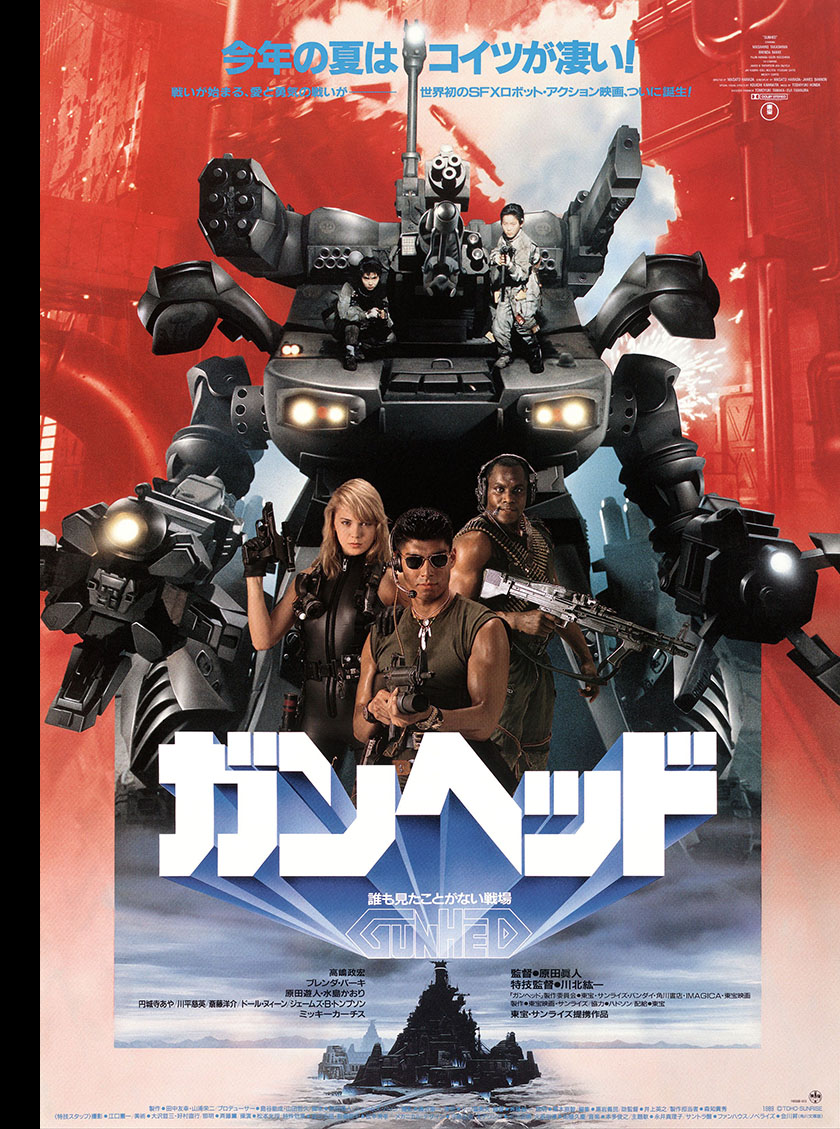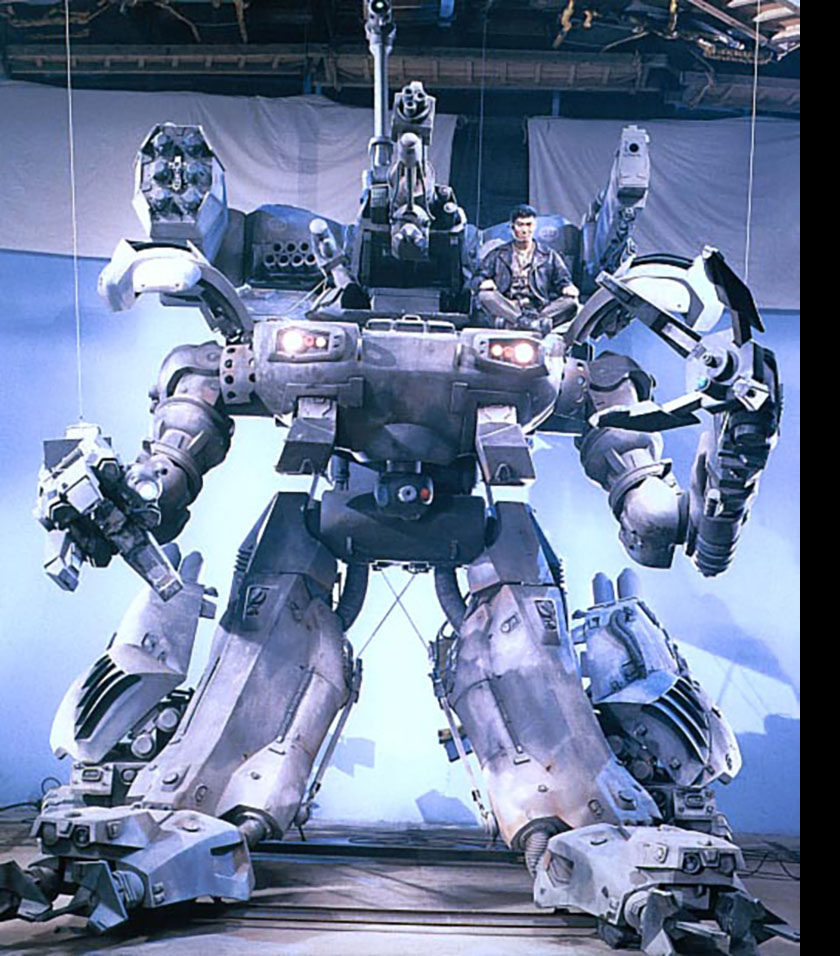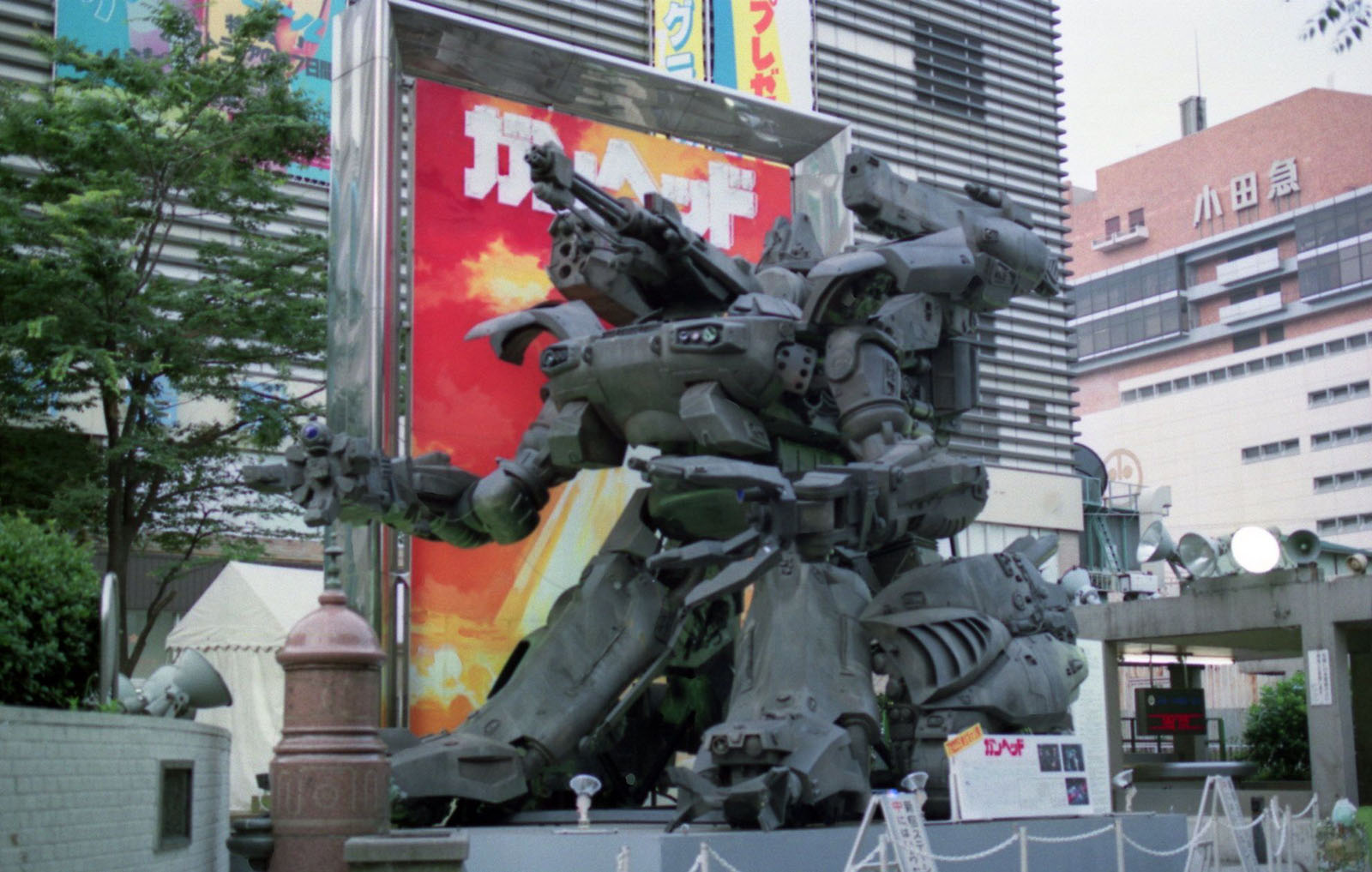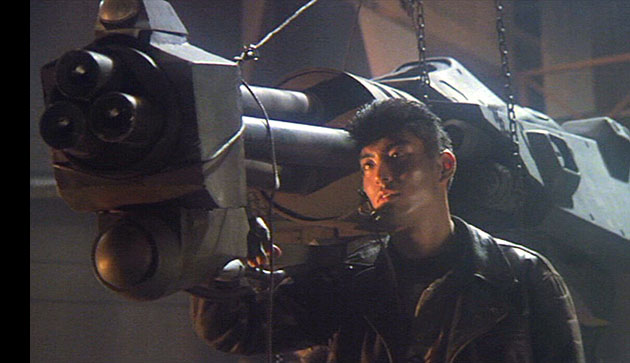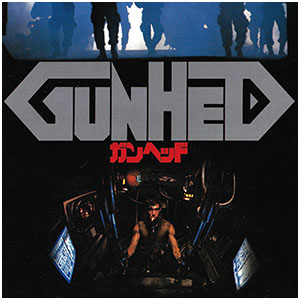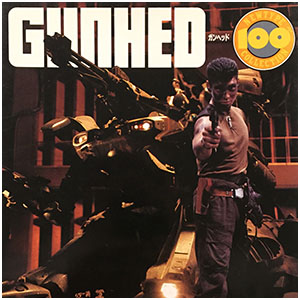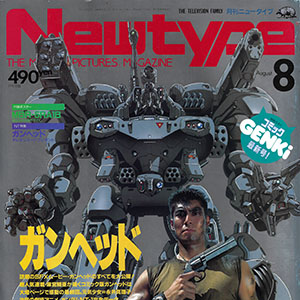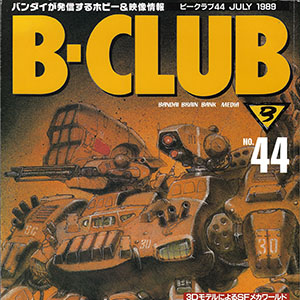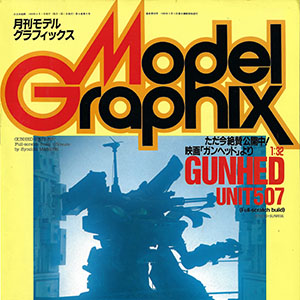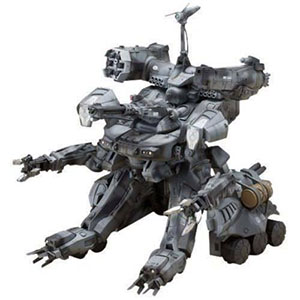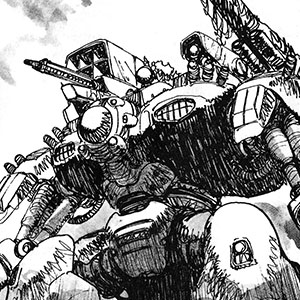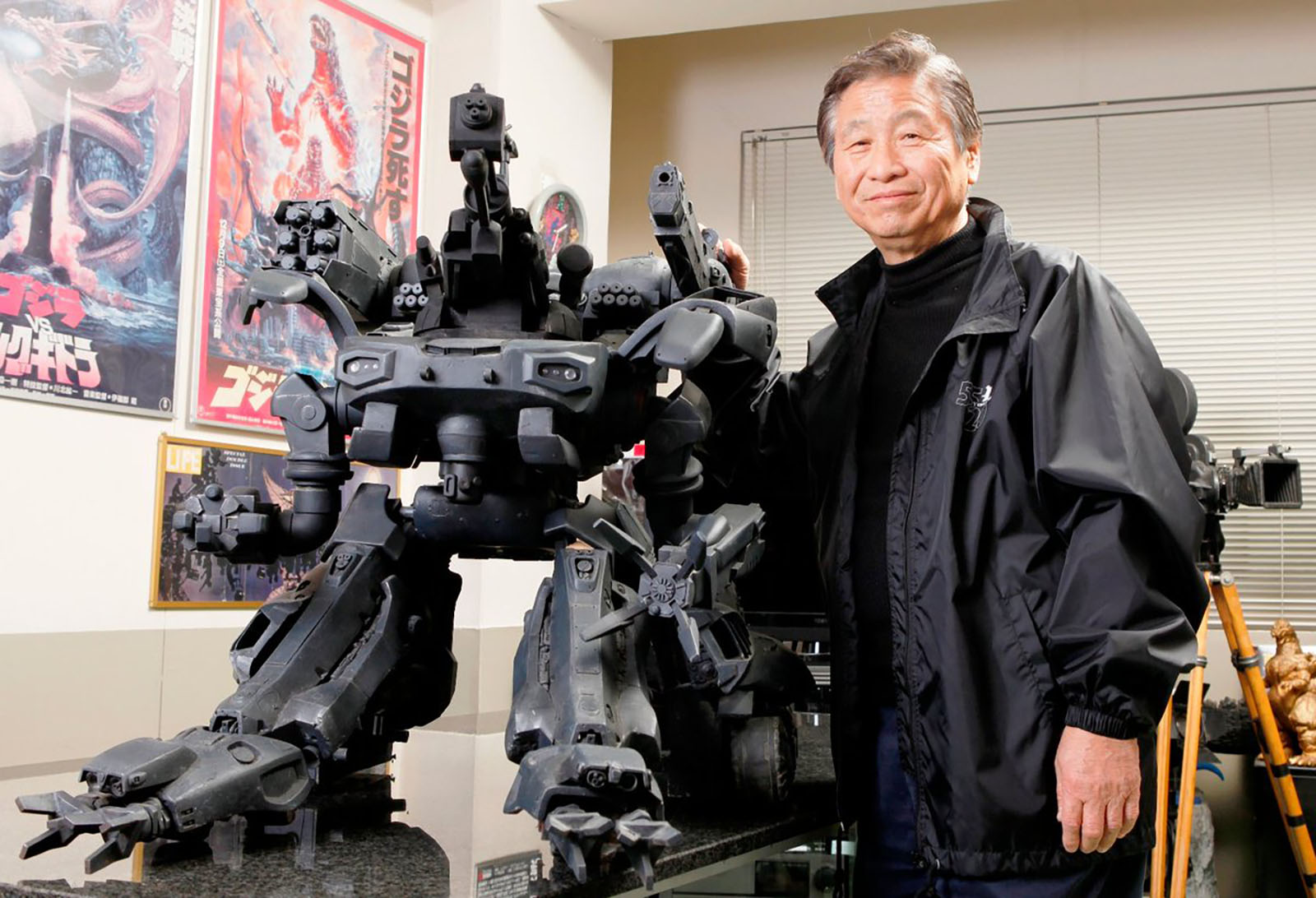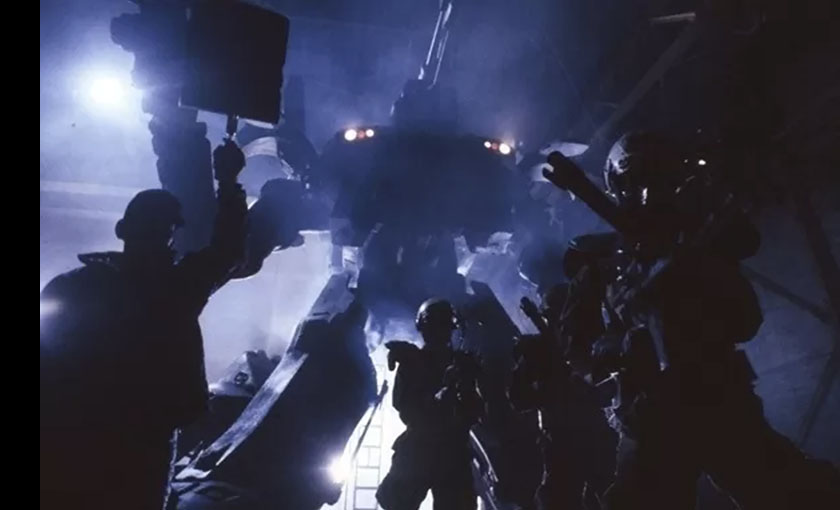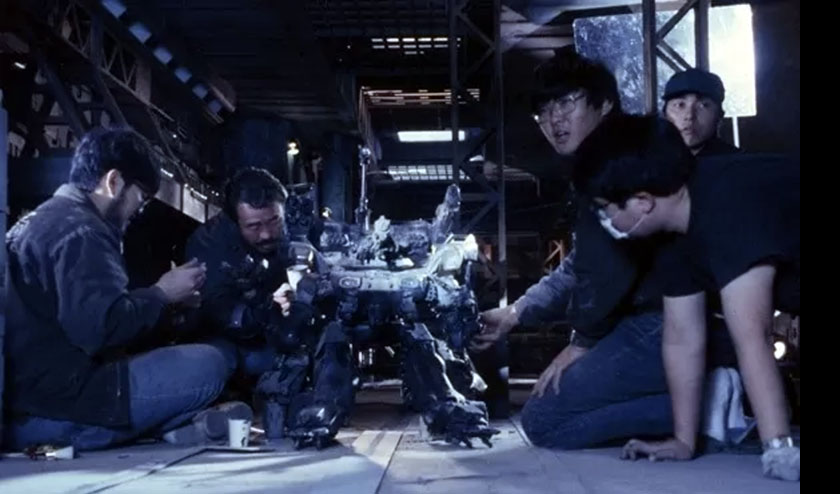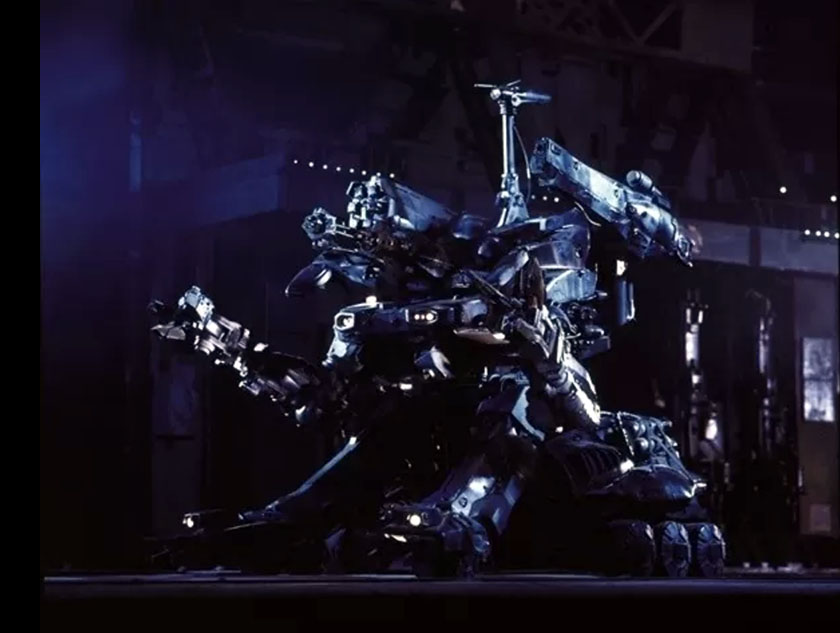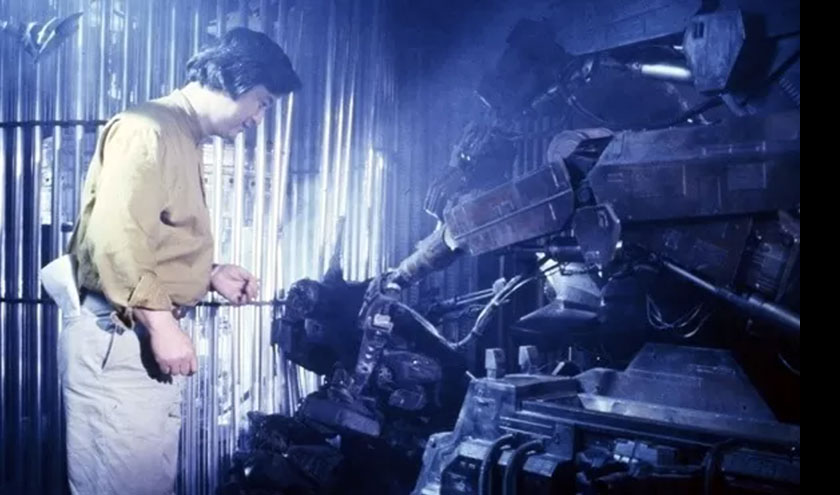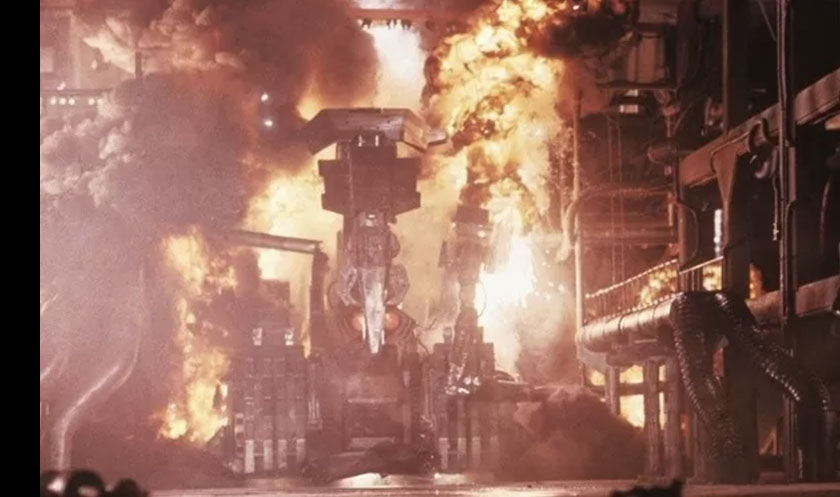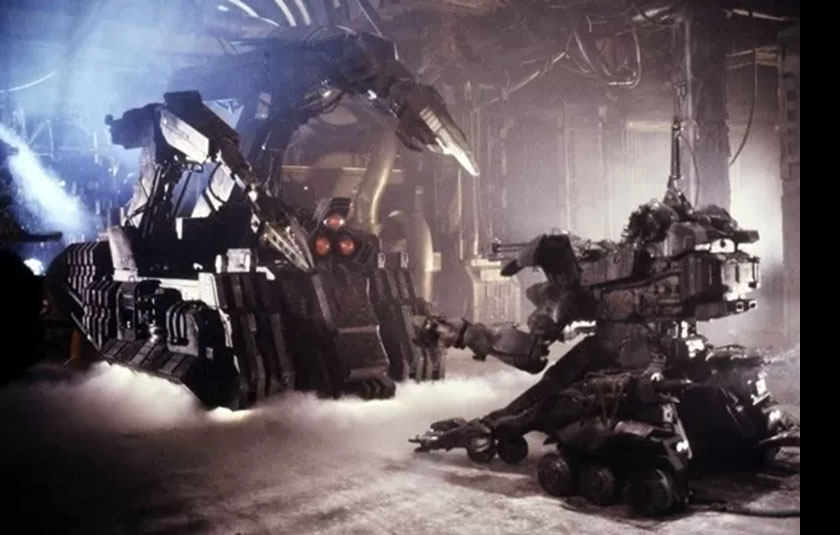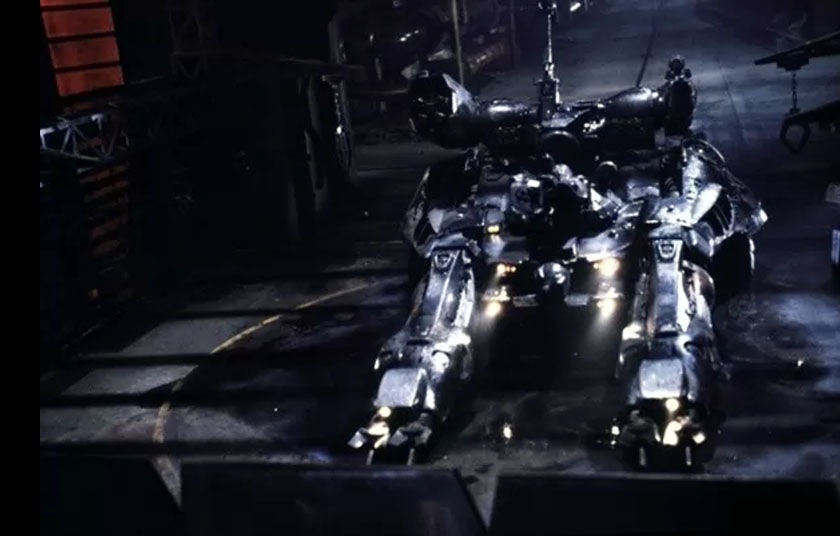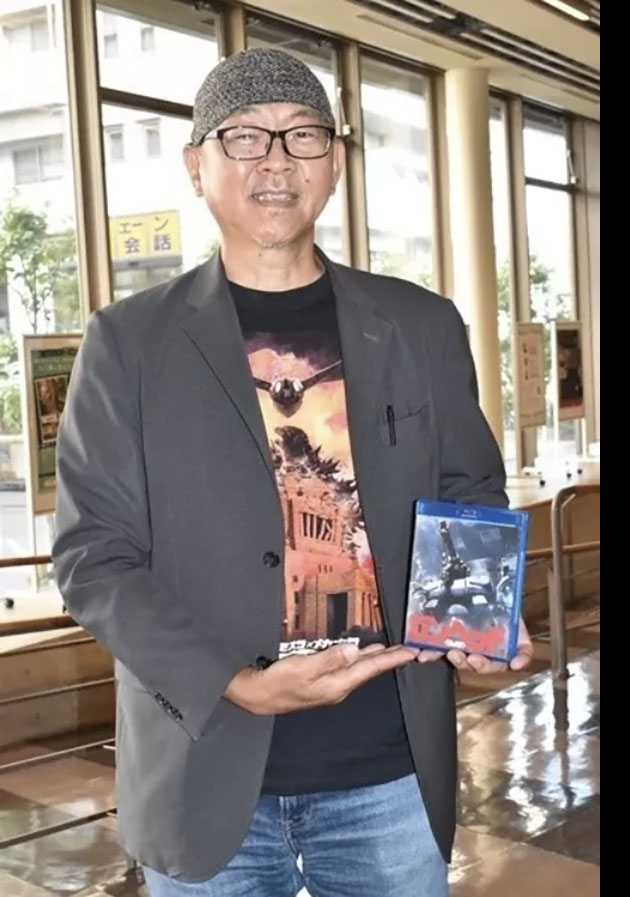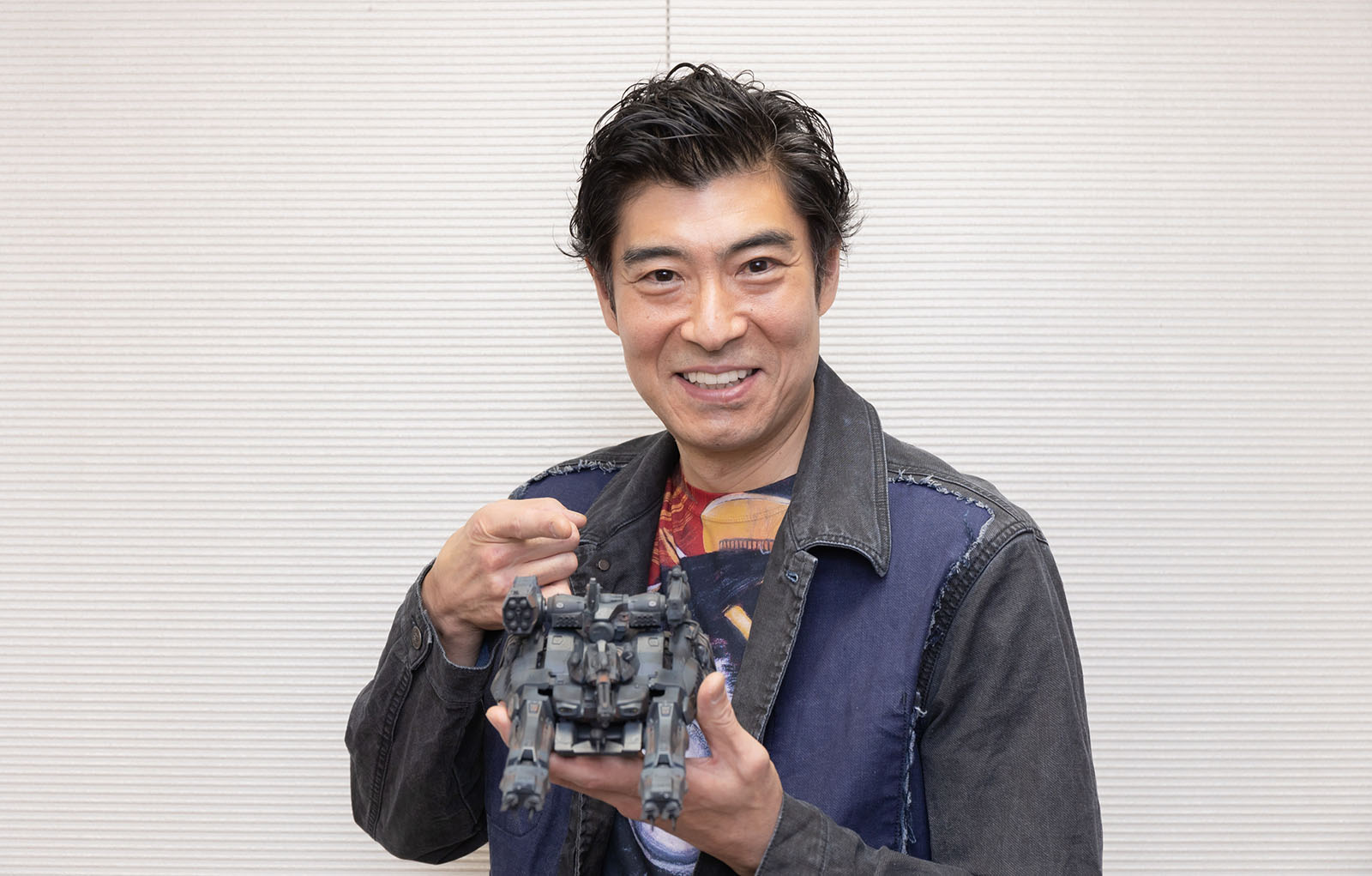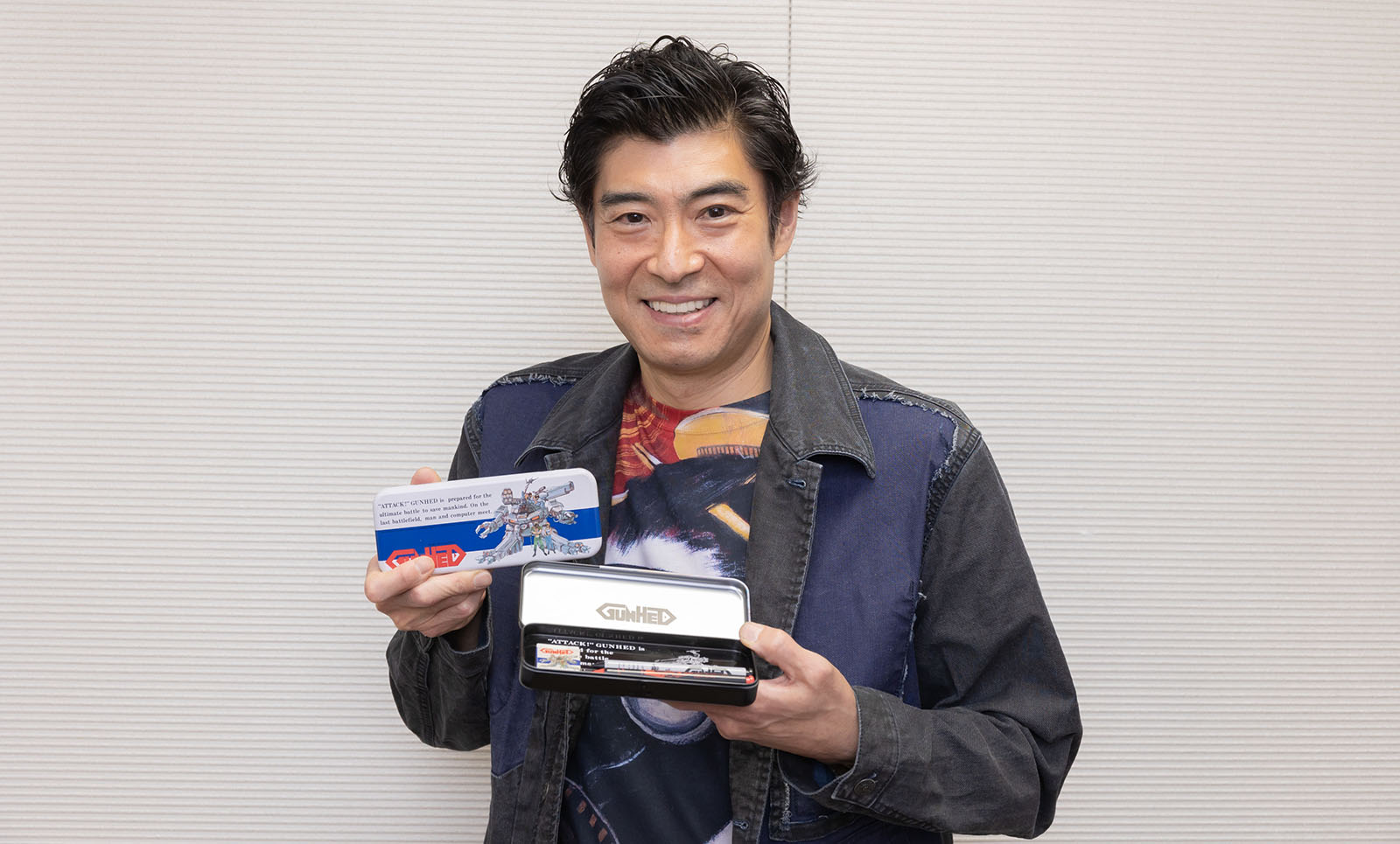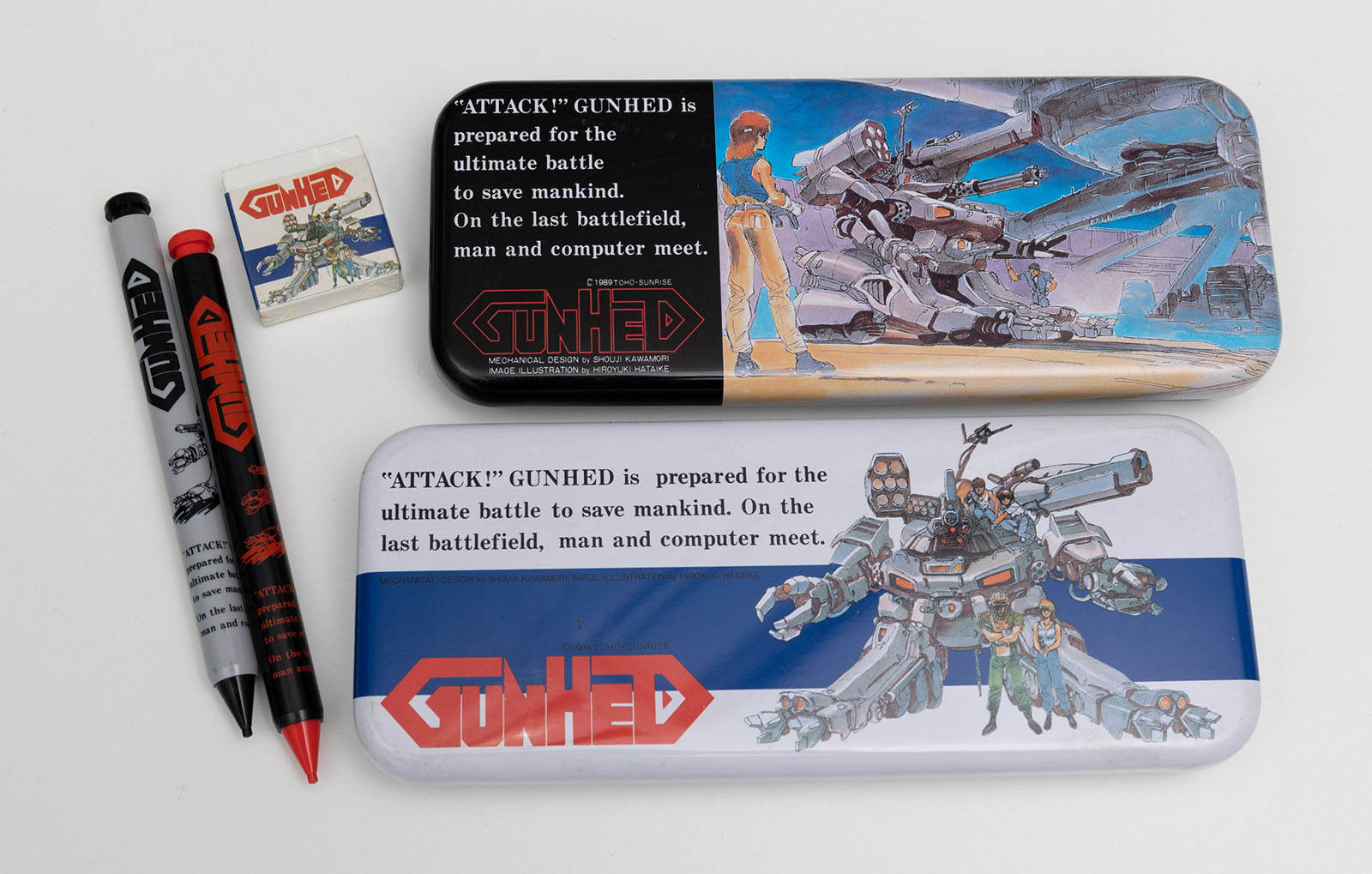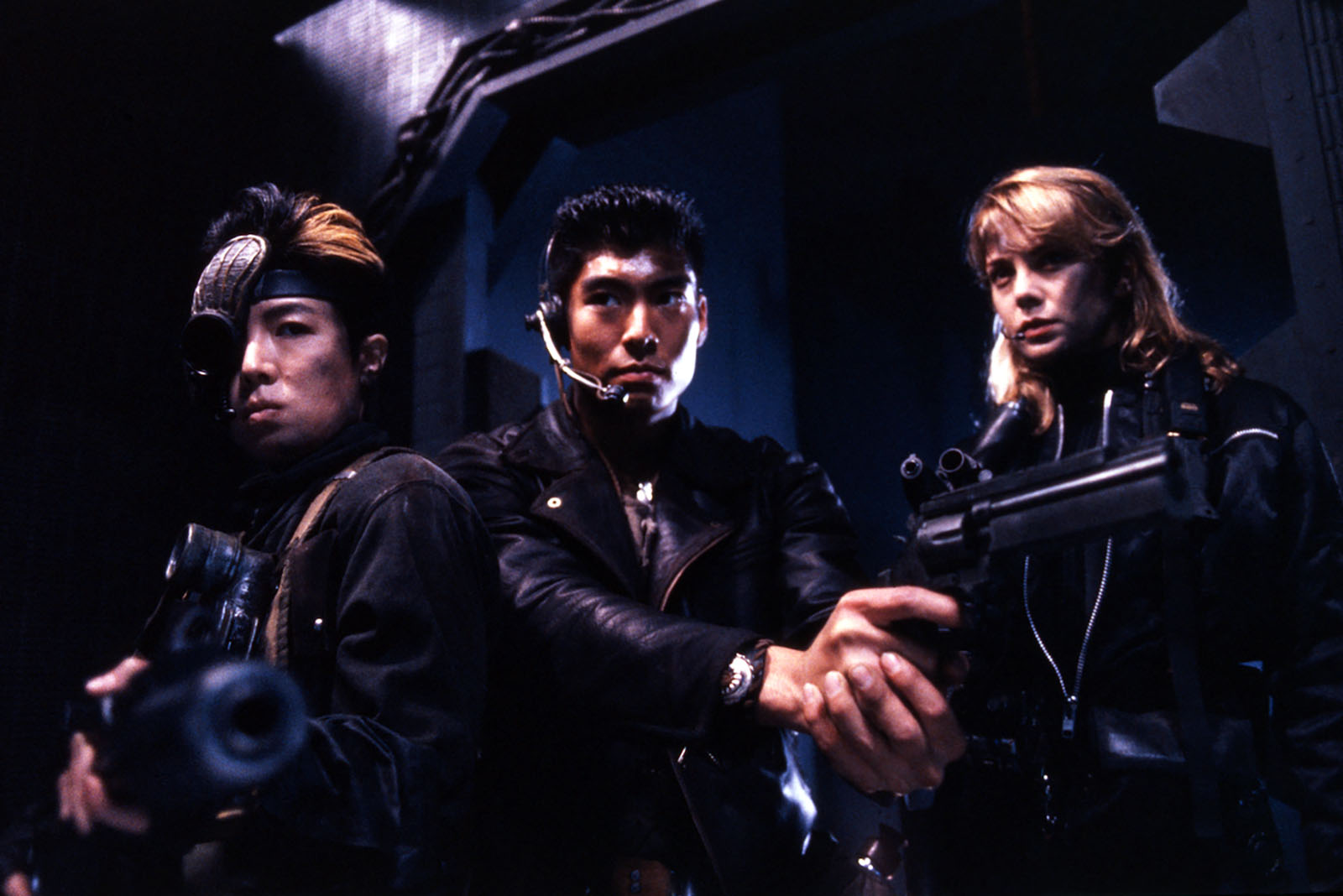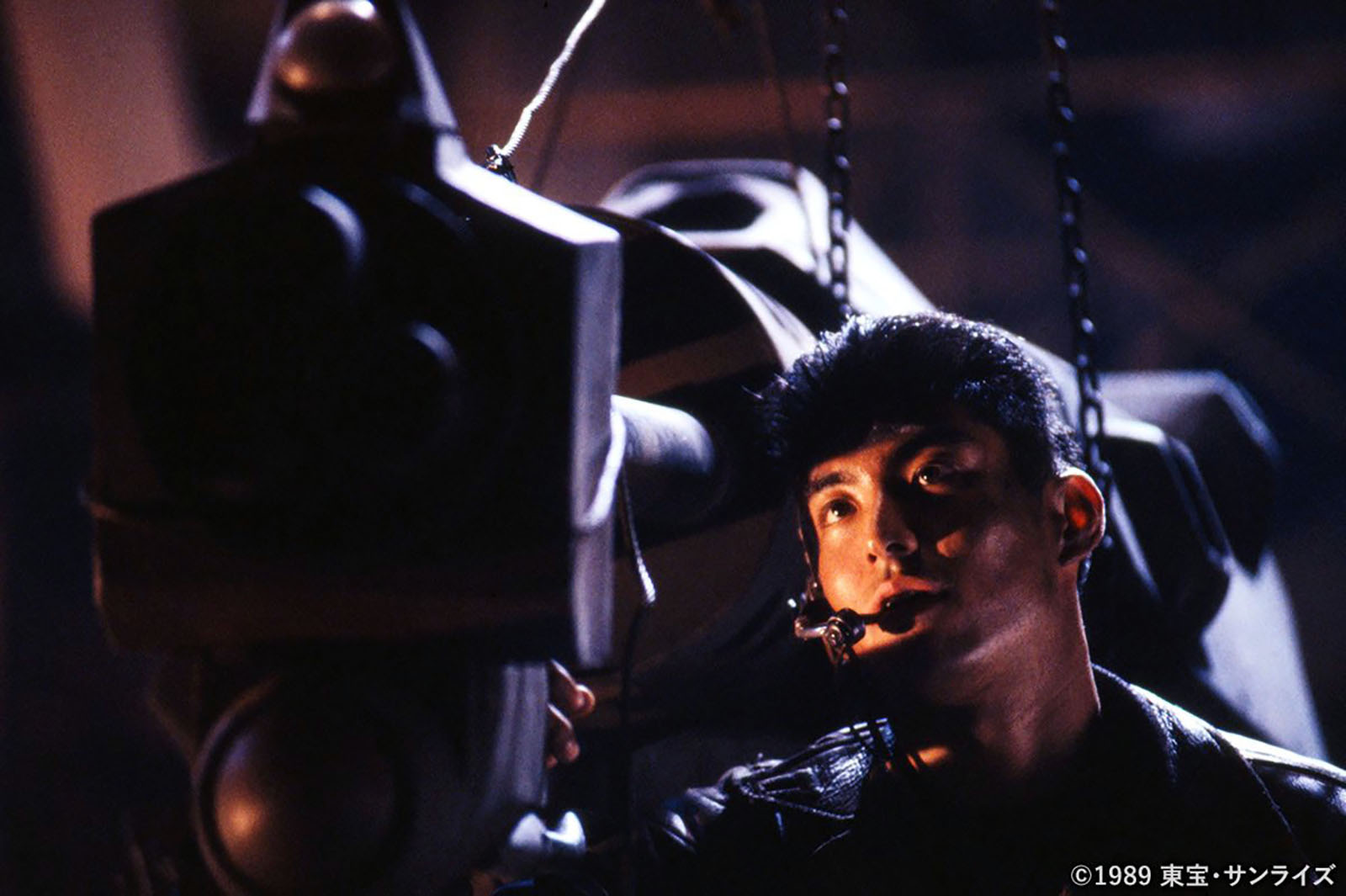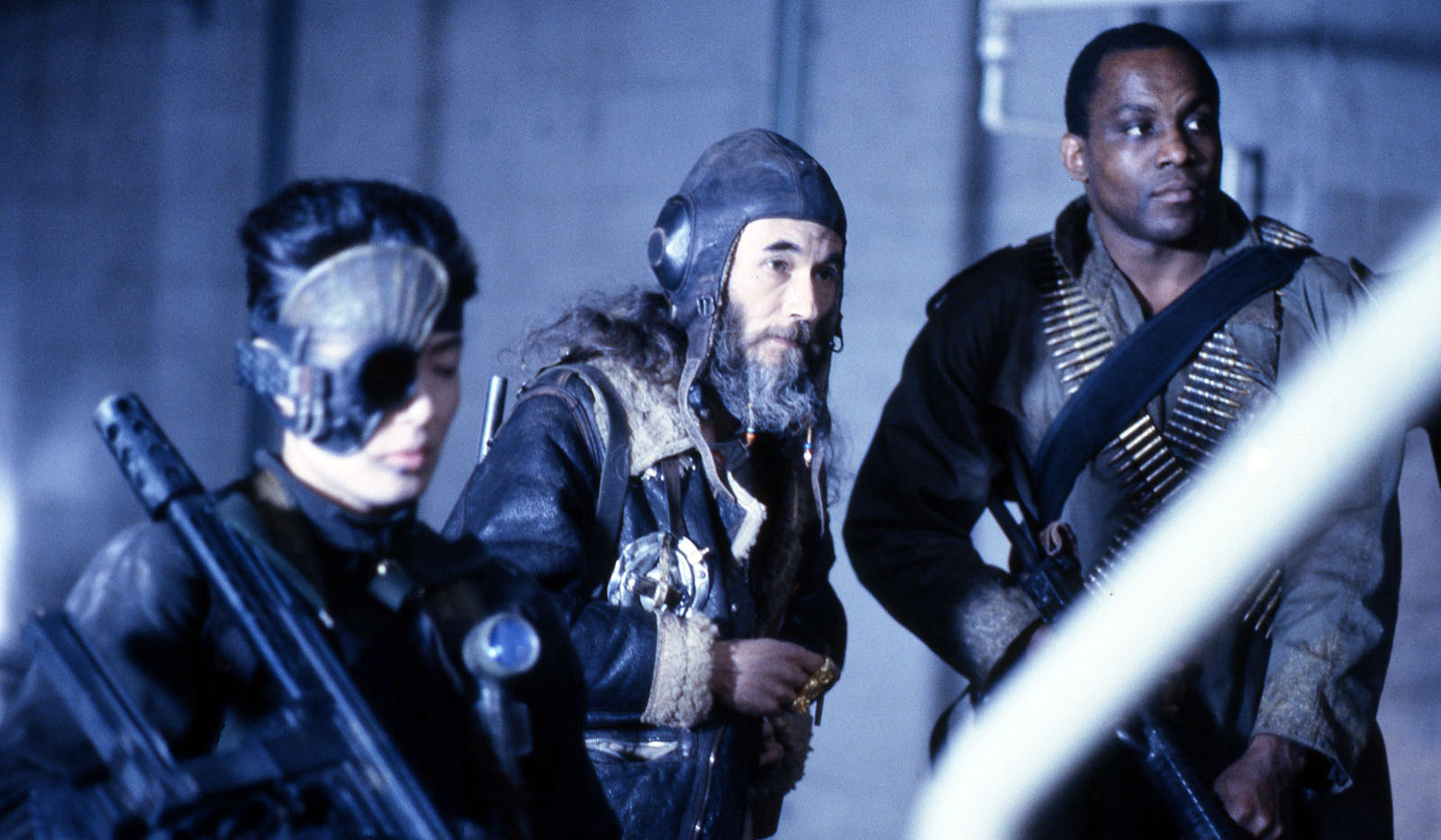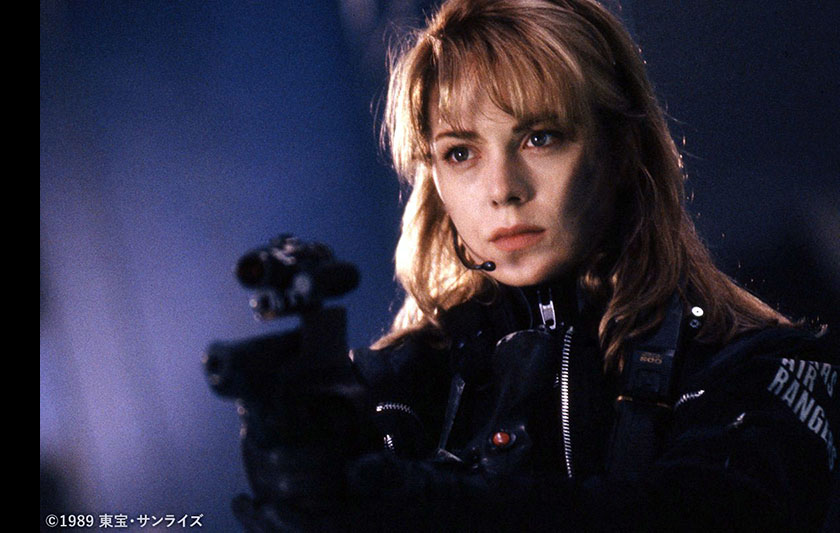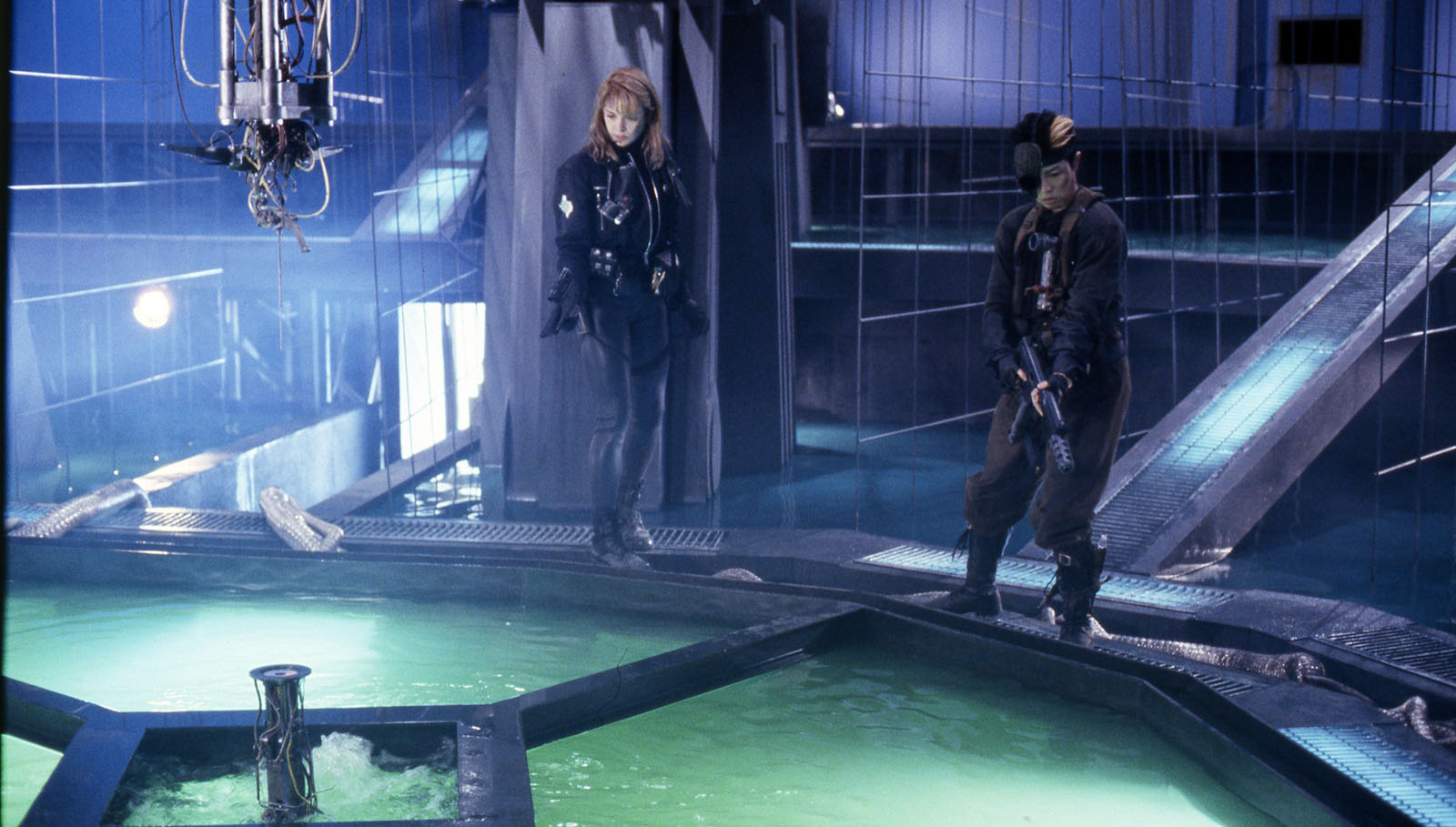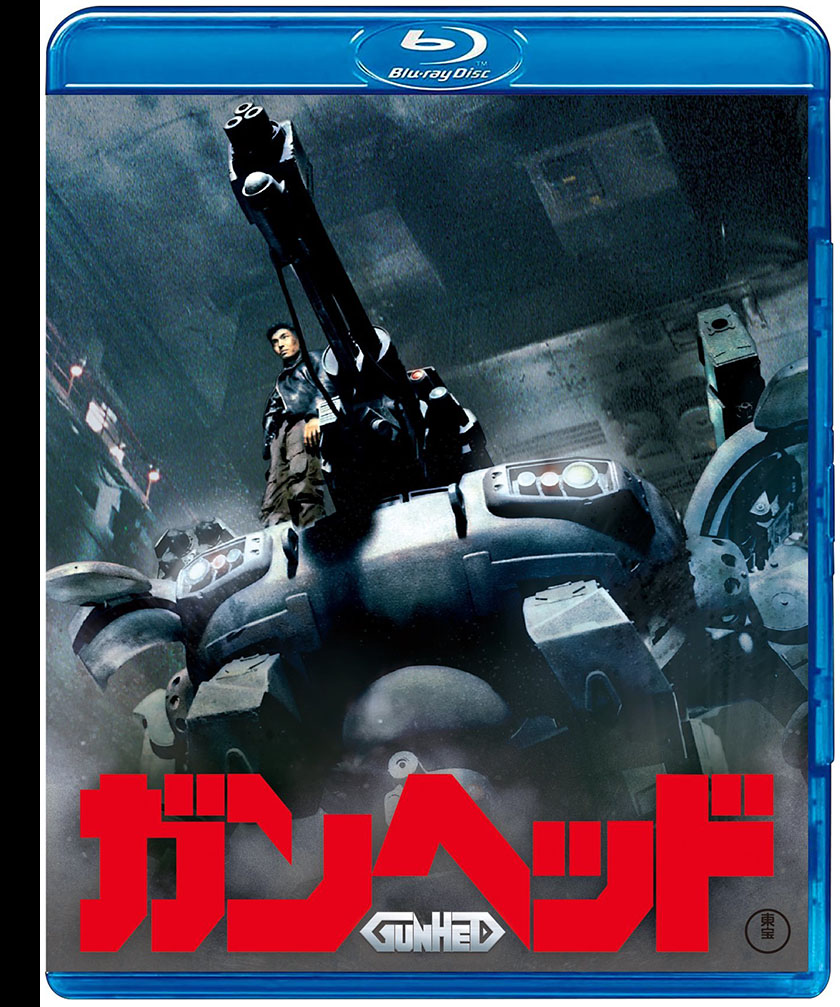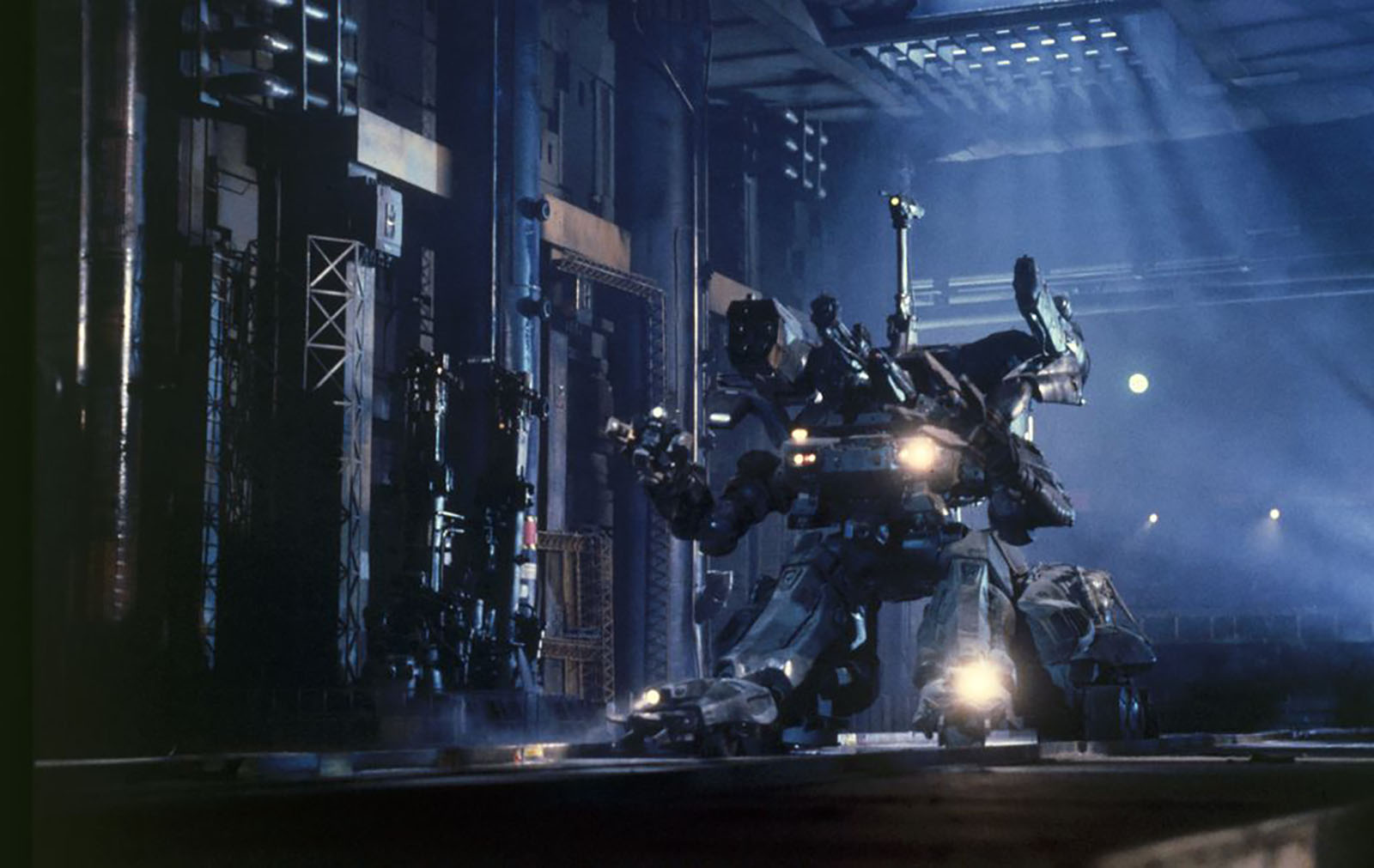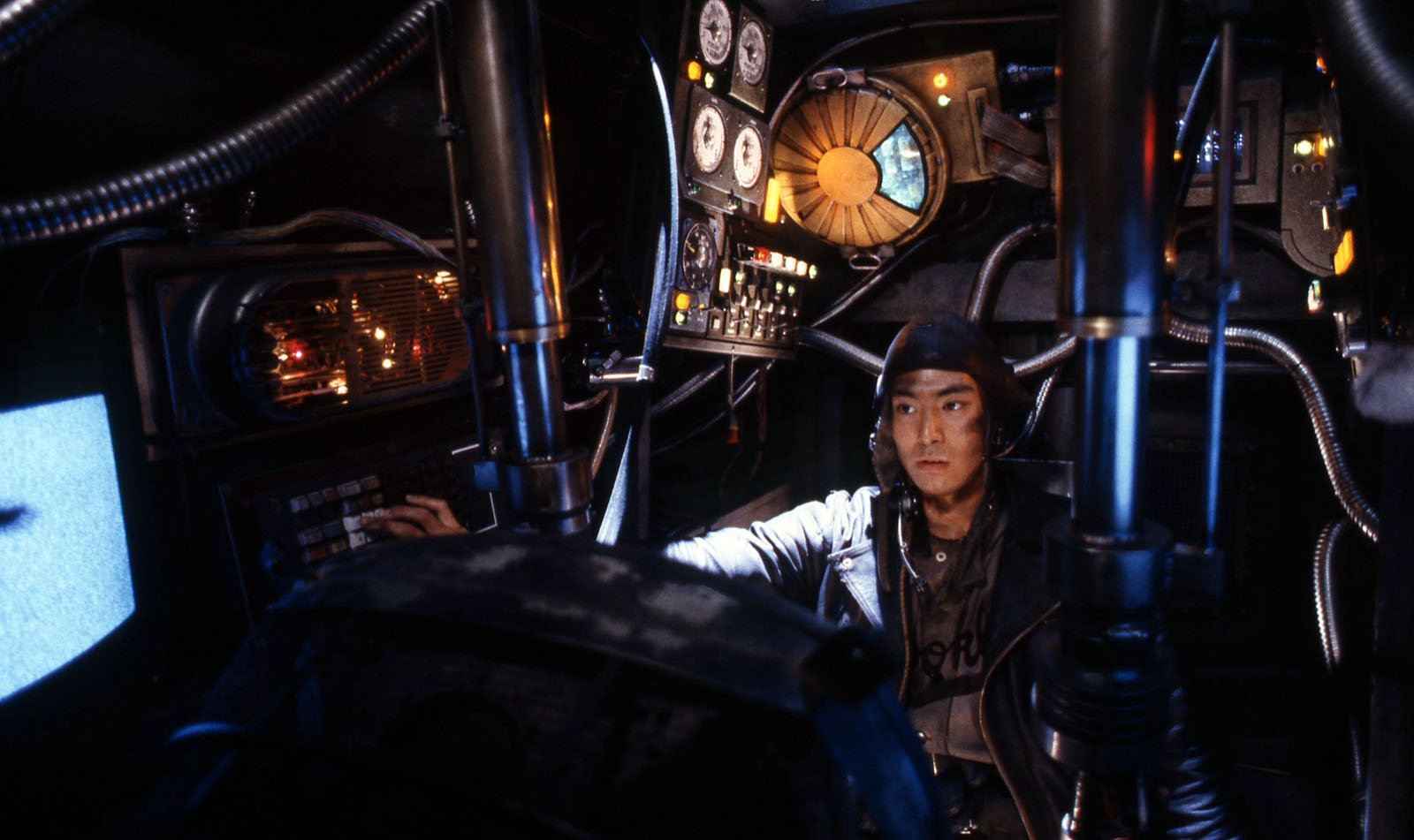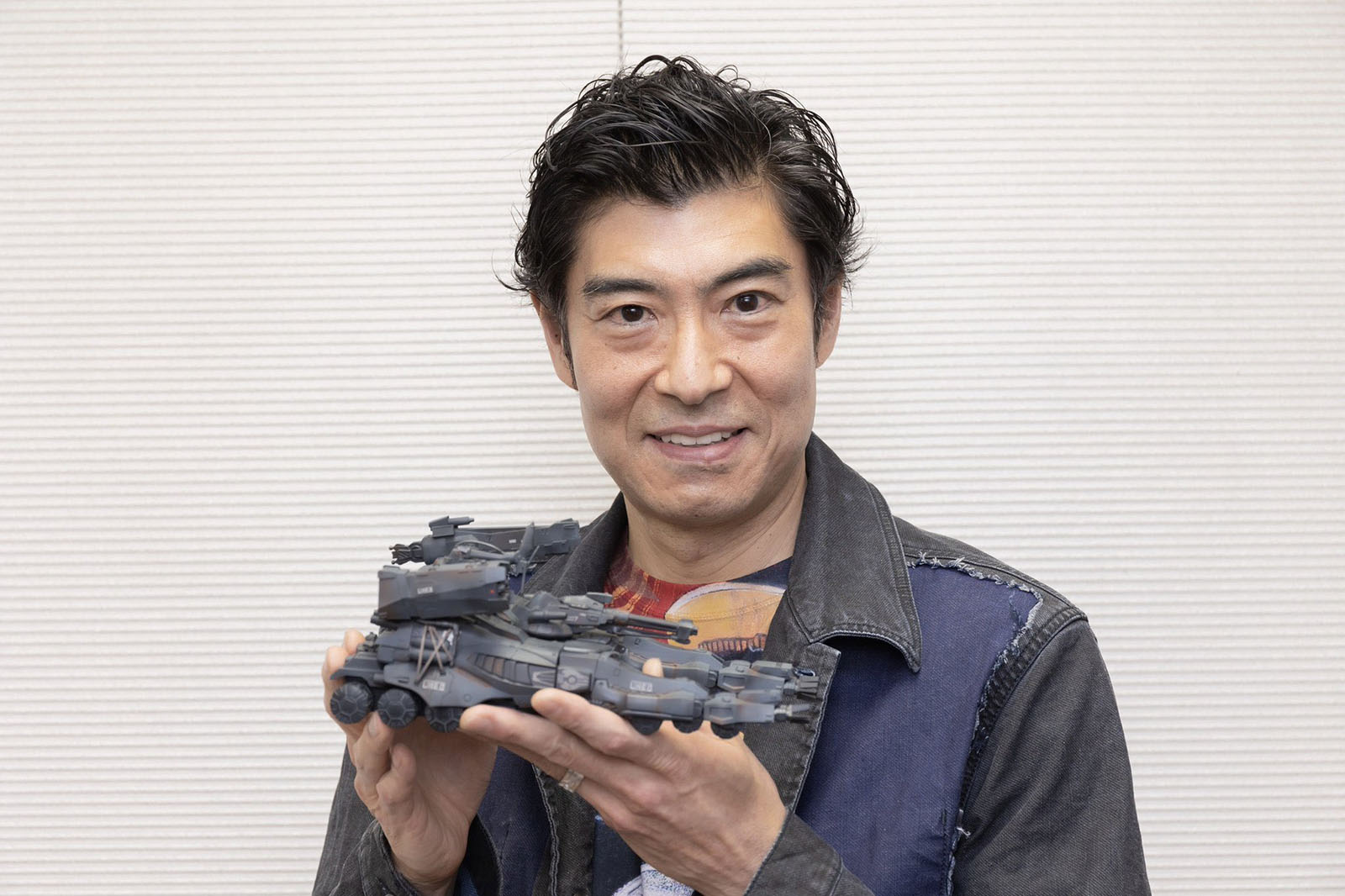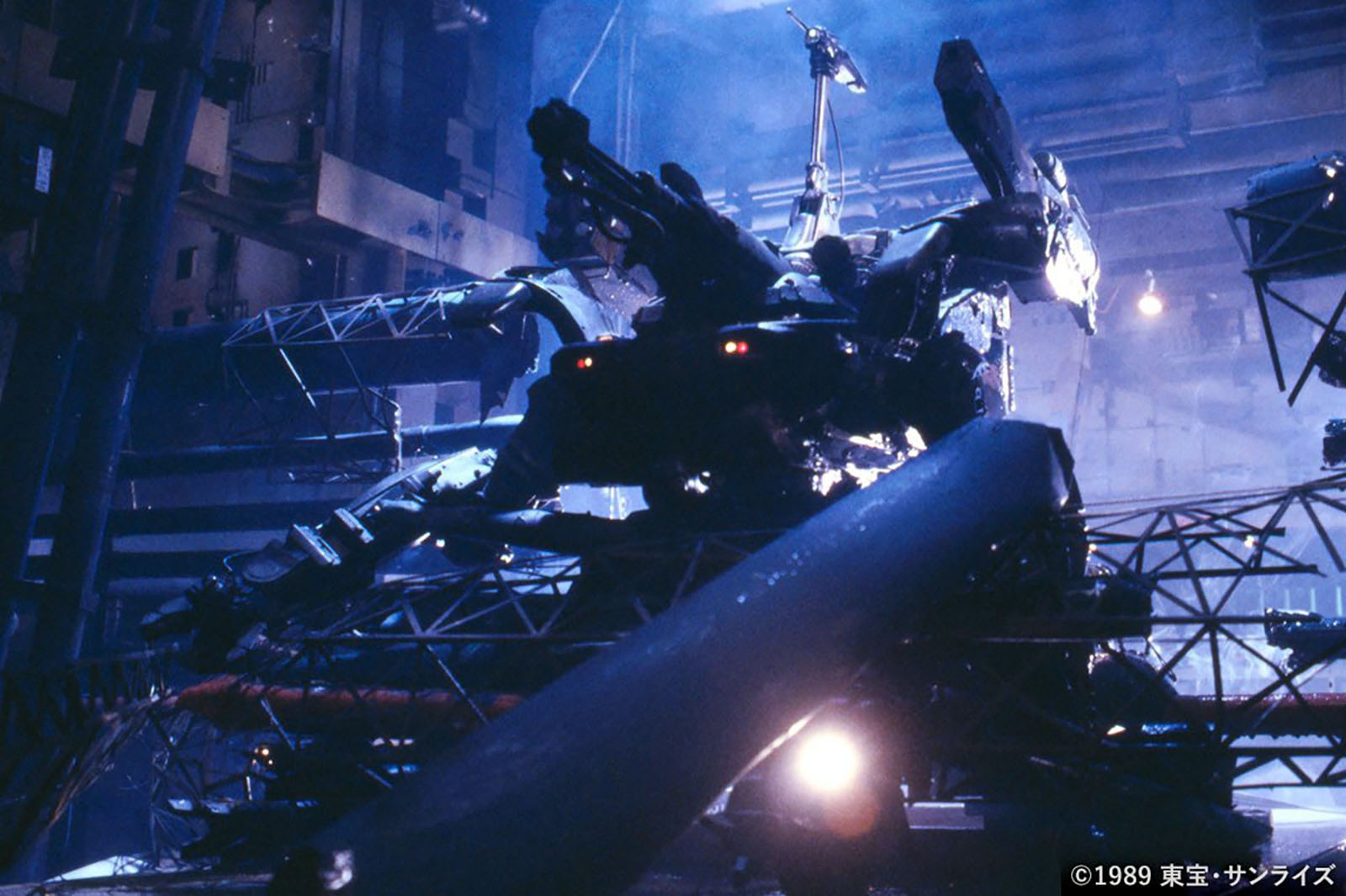Movie profile: Gunhed, 1989
Few “live-action anime” movies succeed in doing justice to their source material. Speed Racer (2008), Space Battleship Yamato (2010) and Battle Angel (2019) are rare exceptions that capture both tone and spirit. But if you want one that embodies the flavor and texture of 80s mecha anime, Gunhed is where it’s at.
I first learned about the film via coverage in anime and hobby magazines I was following in the late 80s. It was the decade of mecha anime, where we witnessed exponential increases in quality and craftsmanship as one title gave way to another. Just as Japan was fueling us with this bounty, our SF films were fueling them. As creative momentum gained velocity, something like Gunhed was bound to happen. The moment I turned a magazine page and got my first look at what was coming, it felt inevitable.
The movie mashed together all the stuff I liked most at that time: future war, cyberpunk aesthetics, SF military technology, apocalyptic backdrops, rogue soldiers, and robots robots robots. Exactly what I was drawing day after day in my BROID comics. The full title of the movie should have been Here Ya Go, Tim. This was no accident, since the concept originated in 1987 with Sunrise, the studio responsible for all my favorite mecha anime, and Armored Trooper Votoms was a major influence.
The story was pretty straightforward after you got through the setup. In the year 2039, Earth is in tatters after an autonomous supercomputer (Kyron 5) declared war on humanity 14 years earlier. It was seemingly defeated on its Pacific Island base (8JO) by a platoon of Gunhed robots that was never heard from again. A team of mercenary treasure hunters named the B-Bangers investigates the island to find Kyron 5 on the verge of waking up again. Most of them are killed quickly (within the first 15 minutes, in fact) until we get down to one survivor, named Brooklyn. He meets other survivors and finds the wreckage of a Gunhed in a junkyard of robot parts. He brings the robot back to life and they struggle to take down Kyron 5 before it can pronounce its death sentence on humanity.
Thanks to a vibrant tape-trading network, I scored a VHS copy as soon as possible and ate that thing for breakfast, lunch, and dinner. To my surprise and delight, half of the dialogue was in English. I found out much later that the director, Masato Harada, was bilingual and spent several years learning his craft in Hollywood, so it was probably done with the calculus of making the movie easier to export. I couldn’t grasp everything the Japanese actors were saying, but the story was well within reach despite some weird editing choices that turned parts of it into a hot mess.
But the best parts of Gunhed needed no translation at all; the cinematography, special effects, sound design, and music were all an easy matchup to anything made in the West. The miniatures blended seamlessly with the full-scale action, making it the last great analog SF movie before the rise of CG. It’s barely aged since then, still as solid and realistic as it ever was.
Some very elite anime designers were involved in creating the title mecha, starting with Kunio Okawara (Gundam/Dougram/Votoms/Layzner/etc.) and culminating with Shoji Kawamori (of Macross fame) with an assist from Hiroyuki Hataike (illustrator of Votoms’ Blue Knight novels). When Kawamori mounted a cannon on the head, he named the robot “Gun Head.” The name was modified to “Gunhed” to stand for “Gun unit – Heavy Elimination Device.” A full-up 1/1 scale version of the robot was built for actors to work with, and was heavily photographed for the magazine articles that grabbed my attention.
Toho veteran Koichi Kawakita shared the director credit with Masato Harada, both working in parallel. Harada presided over the 1/1 world with the human actors and life-size robot. Kawakita mainly dwelled in a 1/8 world of miniature Gunheds and the massive tech facility that became their obstacle course. After Gunhed, he began a long run on the Heisei-era Godzilla films.
A big-deal promotional campaign landed many articles in anime and hobby magazines, one element of which was a manga version adapted from the script by Kia Asamiya. It was serialized in five consecutive issues of NewType and later collected into a single volume. Meanwhile, manga artist Kazuhisa Kondo did a one-shot story for B-Club that was folded into their coverage. The pre-release campaign was loaded with things like this, all setting the stage for something that could only be made in this time and place in history.
The movie premiered on July 22 and…fizzled. Audiences found it hard to follow thanks to the weird editing I mentioned earlier, and it probably didn’t help that all the English dialogue had to be subtitled in Japanese. This was addressed in 1992 when the film was broadcast on TV with re-recorded and slightly rewritten Japanese dialogue throughout. Apparently, the reaction to this version was improved, but far too late to save a dispiriting box office performance.
In America, a similarly experimental SF movie called Blade Runner had the same experience seven years earlier. Big expectations, dazzling visuals, confused audiences, disappointing box office, and general presumption of failure.
But history had a redemption arc waiting for both films. Both Blade Runner and Gunhed achieved cult status over the next few years, eventually emerging with much greater acceptance after audiences came around. After the initial home video release in Japan, the first international version appeared in the early 90s, but with enough changes to prompt Makoto Harada to take an Alan Smithee credit.
A Japanese DVD release in 2007 seemed to start a slow revival. 2013 gave us an elaborate 1/35 model kit from Kotobukiya and a fantastic making-of book from Ascii Media Works. Those who played the Super Robot Wars video game were amazed when Brooklyn and Gunhed were offered as playable characters for X-Ω in 2015 with the original actor reprising his role. The film finally graduated to Blu-ray in June 2022 and brought about the redemption moment; the Blu-ray ranked #1 in sales of SF movies, and a revival film screening in July sold out instantly.
Regardless of how Gunhed did in its opening weekend back in 1989, the full sweep of its history on Earth shows that it succeeded in every way it deserved to. And now that history can be fully explored in the links and articles below.
LINKS
Masahiro Takashima (Brooklyn) 1989 interview
Trailer and commercial collection
Gunhed in Super Robot Wars X-Ω (promo)
Gunhed in Super Robot Wars X-Ω (gameplay)
Gunhed in 2022
Special Effects Director Koichi Kawakita
Art Director Toshio Miike Discusses the Appeal of Gunhed, a Live-action Giant Robot Battle Action Film Created by the “Heisei Godzilla” Special Effects Team
Author:Hideo Akita
Posted July 31, 2022 at My Navi News.
See the original article here.
Toho, known for its special effects monster movies such as Godzilla, and Sunrise, known for Mobile Suit Gundam, once teamed up to create the film Gunhed (1989, directed by Masato Harada). The film is set in a future Earth ruled by a giant computer. Brooklyn, a young man who rides the giant robot Gunhed, and his friends fight to the bitter end in this “SF tokusatsu mecha action work.”
This film was released in the year the Showa Era was replaced by the Heisei Era, with the aim of creating a science-fiction special effects film for the new era. Koichi Kawakita, who would later revive Godzilla for the first time in five years with Godzilla vs Biollante (1989), served as special effects director. Gunhed, which can be called “the starting point of Heisei Godzilla,” is an unforgettable and ambitious film for Japanese tokusatsu fans.
Gunhed is once again attracting a great deal of attention. When the Blu-ray version was released on June 15, 2022, it was ranked No. 1 in sales of “Japanese SF movies” on a mail order site. The re-release of the Gunhed 1/35 scale model from Kotobukiya was decided for the first time in 10 years. A Gunhed 35mm special screening held in Ikebukuro, Tokyo on July 8 sold out in advance.
Actor Masahiro Takashima, who played the lead role of Brooklyn, spoke passionately about his love for Gunhed in a commentary video. After the screening, Kaori Mizushima, who played Eleven in Gunhed, took to the stage wearing a Gunhed T-shirt, which will be on sale soon. She talked about her career in tokusatsu TV series such as Ultraman Dyna (1997) and Kamen Rider Cougar (1998) as well as the filming of this movie.
The event was attended by many Gunhed fans, and there was even a scene where everyone in the hall called out the famous line from the movie, “Let’s party, Gunhed!”
We interviewed Toshio Miike, who assisted Tetsuzo Osawa in creating the drawings for the Gunhed miniature, operating and maintaining the miniature, and designing Gunhed’s formidable enemy, the Aerobot. He has a career in Toho’s special effects department and has worked on Gamera (1995) and Shin Godzilla (2016). He is a veteran staff member with decades of experience in this field.
He has a strong attachment to Gunhed, in which veteran crew members with decades of experience worked together with young crew members with passion to create a better image.
Interviewer: Could you tell us how you came to participate in Gunhed?
Miike: I moved to Tokyo from Kyushu in 1984 with my classmate Hiroshi Butsuda (special effects director). I worked with Nobuo Yajima (special effects director) at his “Tokusatsu Laboratory” on Bioman (1984) and Space Sheriff Shaider (1984). Since then, I’ve been working as an art assistant for super Sentai series and other tokusatsu.
In 1988, I left the Tokusatsu Laboratory because I wanted to experience various other productions, and became a freelancer. (He returned to the Laboratory in 2008.)
Eventually, I was hired for NTV’s year-end period drama special Goryokaku (1988; special effects director Koichi Kawakita and the Toho special effects team were in charge of directing the special effects scenes), and then Gunhed came next. When I heard that Koichi Kawakita was the special effects director and Naoyuki Yoshimura was the art director, I really wanted to be a part of this project.
Interviewer: What kind of people were on the art team for Gunhed?
Miike: Mr. Yoshimura was the assistant to Yasuyuki Inoue, the special effects art director for Toho tokusatsu films such as Japan Sinks (1973), Tokyo Bay in flames (1975) and Godzilla (1984). Under him were Yuji Terai, Tsuyoshi Shimizu, and Isao Takahashi. I was there, and Yuji Tsuzuki and Masato Inazuke also joined us. All of them are now art designers. Tetsuzo Osawa joined us at the invitation of Director Kawakita. Gunhed started with Mr. Yoshimura and Mr. Osawa as the double art designers.
Interviewer: So the tag team for Gunhed was Special Effects Director Kawakita, and Osawa the designer, who was on the Heisei Godzilla series starting with Godzilla vs Biollante?
Miike: I think Kawakita-san wanted not only Toho staff to participate in the project, but also new talents who had built their careers at other companies. When he saw the miniature work of the Taisho era Tokyo cityscape for Teito Monogatari (1988), he recognized Mr. Osawa’s ability.
Interviewer: What kind of work was did you mainly do for Gunhed?
Miike: At first, I was present for the miniature shoot. I took care of everything myself, including preparation, assistance, and repairing broken parts. Gunhed was designed to transform into upright mode, tank mode, and tunnel mode. The miniature was available only in the upright and tank mode, while the tunnel mode was a modified version of the upright mode.
The assistant operator, Yasunobu Katori, had excellent skills. He made a gimmick to transform from running mode to upright mode by disassembling parts. Gunhed also had “stuffed animal” type (1/3 scale) that can be worn by a human being. We made drawings and models of the “stuffed animal” type.
Mr. Osawa asked me to work on the enemy Aerobot as well, and I was entrusted with all aspects of the project, from the final design to the miniature drawings. Aerobot was much larger than Gunhed, with a built-in air cylinder, movable arms, a fluorocarbon gas injection gimmick, and it could run on its own, albeit slowly. I remember when Koji Matsumoto, who was the operator of the robot, called Aerobot a “monster.”
“Hey, bring the monster!” (Laughs)
Interviewer: What are your memories of the special effects for Gunhed?
Miike: I think Gunhed was a monumental work that introduced a new trend to the traditional “Toho tokusatsu” of the past. For example, in previous productions, we would first build the set to fill the stage, and then decide the camera angles. Therefore, there were times when the camera couldn’t be placed at the angle I wanted to shoot from. If you really wanted to shoot from there, you had to dismantle part of the set, which was inefficient.
In Gunhed, Mr. Osawa’s idea was to make the walls of the set in sections and reassemble them for other sets. Therefore, there was a large degree of freedom for the camera to be placed in the set. This method is very reasonable. When I worked on the special effects for Heisei Gamera and Godzilla films, I made the set movable so that the camera could be placed anywhere.
Also, since most of the story takes place indoors (mainly inside Kyron’s Mother Tower), I tried to avoid similar images in the set design, the way of shooting, and the lighting. I tried to make it look like we were moving from one place to another.
Interviewer: What do you think about the direction of Koichi Kawakita, the special effects director?
Miike: The first time I worked with Mr. Kawakita was on Gunhed. He had experience working under directors such as Eiji Tsuburaya and Akiyoshi Nakano, so he was familiar with the pros and cons of manipulation and special effects. He also had experience in the compositing department, so he was well-versed in what kind of methodologies could be used to achieve the desired images. Therefore, the discussions on shooting methods were very specific, and the instructions on the spot were precise. There was almost no trial-and-error in the process.
Even though it took a long time, I think we were able to capture images that were worth the effort. And Mr. Kawakita himself is very dexterous with his hands, so he was able to do a lot of the art work, such as painting and repairing the miniatures. He wasn’t the type of person who just sits in the director’s chair and waits.
When I look at the footage of Gunhed, I’m amazed at how he was able to create such a great image without CG back then. I would say that it was the pinnacle of Japanese special effects at that time. Mr. Kawakita was very particular about the depiction of mecha. Gunhed was a work to which he was perfectly suited.
Interviewer: If you were to make a giant robot action film like Gunhed again, what would you like to try?
Miike: To make the character of the giant robot stand out, I think it would be better to have arms and legs that are easier to understand. But in the world of Gunhed, I think it would be strange if a robot with eyes and noses like those in Transformers appeared in the world of Gunhed. (Laughs)
At the time, I thought that since Sunrise was teaming up with Toho to make a live-action robot, they should make a smart humanoid robot. But I think that if we had done Gunhed as a humanoid robot, we might never have been able to finish it. (Laughs)
Profile
Toshio Miike is an art director.
Born in Kumamoto Prefecture in 1961, he graduated from Kyushu University’s Faculty of Engineering in 1984 and joined the “Tokusatsu Laboratory.” He studied under Nobuo Yajima (special effects director) with his classmate Hiroshi Butsuda (special effects director/representative of the Tokusatsu Laboratory).
He worked on Metal Hero, various Super Sentai series, Gunhed (1988, special art assistant, 1988), and Godzilla vs Biollante (assistant director, 1989) He has also worked on many other films, including Gamera: Daikaiju Kairyu Kessen (effects artist, 1995). He served as special effects director for Kadokawa’s Daimajin Kanon (2010) and Tsuburaya Pro’s Ultraman Saga (2012).
Meet the legendary man, Masahiro Takashima, and talk about Gunhed
Posted June 15, 2022 at SPICE. See the original article here.
In commemoration of the first Blu-ray release of the legendary special effects movie Gunhed, we talked to Masahiro Takashima, who played the role of Brooklyn, the main character in the film.
In 1989, Toho Pictures, which has a long history of producing live-action tokusatsu films such as the Godzilla series, and Sunrise, which has a long history of robot anime such as Mobile Suit Gundam, made the first live-action giant robot movie in history. The name is Gunhed (!!!!)
Gunhed was not a big hit at the time of its release, but its mecha depiction and worldview deviated from the usual scale of Japanese films. The film’s unique direction, in which English and Japanese coexist in the same room, and the presence of Masahiro Takashima, who played the main character Brooklyn, continues to attract a growing number of fans.
In 2022, the first Blu-ray version of Gunhed was announced. The dubbed TV version was also included in the Blu-ray release, and it was a big hit with Gunheaders. To commemorate the Blu-ray release, we asked Masahiro Takashima to share his passionate love for Gunhed. Please enjoy it in standing mode!
Takashima: I brought something good for you today!
Interviewer: School supplies from back then!
Takashima: I’ve been using this for a while. I used up one of the erasers. (Laughs)
Interviewer: You must have loved it! I’m also moved by the fact that you kept this for so long.
Takashima: Please take a look at it later.
Interviewer: A precious thing out of the blue…
At Toho, Godzilla and tokusatsu were God
Interviewer: Today, I’d like to talk about the upcoming Blu-ray release of Gunhed on June 15. You played Brooklyn in the movie, and we’d like to look back on it and hear your story.
Takashima: Thank you. Today I’ll tell you everything!
Interviewer: Thank you! When the Blu-ray release of Gunhed was announced, there was an explosive response. It’s been 33 years since its release, and I was surprised that there are still so many enthusiastic fans.
Takashima: People still bring me the program book for Gunhed and ask me to sign it. Of all the films I’ve been in, Gunhed is the only one where people still bring me programs. And there are crew members on movie sets who were old enough to have seen Gunhed in elementary school. In between takes, they say, “I saw Gunhed! I was so moved!” That’s when I realize that Gunhed is a very special film.
Interviewer: Well, today, I’m a musician, designer, and editor-in-chief. We all have a passion for Gunhed. In that sense, it really is a very influential work.
Now, I’d like to ask you about the shooting of the film. Gunhed has a different worldview from your other works. What was the process leading up to your performance? You had your debut two years earlier, when you were in college.
Takashima: Director Nobuhiko Obayashi invited Troy Donahue of The Drifting Classroom (1987), to a party he was having at a friend’s house. Director Obayashi told me to join the party, and we took a picture together. When someone from Toho saw it, they said, “If you’re motivated, why don’t you come in for an audition?” So I did. I was cast in Shining Woman (1987) at first, and then I was cast in Totto Channel (1987), which became my debut film.
There was a football game at the time, so I wore a jersey or something like that. Director Kazuki Omori said to me, “You’re funny, while the other guys come all dressed up in jackets.” That’s how I got into Toho.
At that time, tokusatsu films and Godzilla were God, rather than literary works or films that win various awards. So I wanted to make the next tokusatsu movie after Godzilla.
They said, “We are going to make a special effects film after Godzilla, called Gunhed, and you’ll play the main character.” So there was no groundwork. (Laughs) They said, “You’ll do this next,” and I said, “Okay.”
Interviewer: So there was no audition, just a nomination.
Takashima: Yes, that’s right.
Interviewer: Since “tokusatsu was God” at Toho then, being cast as the lead in a tokusatsu movie was a big deal.
Takashima: Yes, it was. But they said I couldn’t be in Godzilla yet. (Laughs)
Interviewer: It was like a preliminary step.
Takashima: I think it was. Anyway, I wanted to make something that wasn’t Godzilla.
“Gunhedism,” speaking Japanese like English
Interviewer: When you decided to participate in Gunhed, what was your impression of Masato Harada’s direction?
Takashima: He asked me to speak Japanese as if I were speaking English. He said, “Takashima, can you review Sahara Tank Corps (1943) and Star Wars again? I’ve already told the whole staff that I want to do this like a John Ford film. It was, “More like William Hurt in Altered States (1980), or Harrison Ford’s Han Solo in Star Wars.”
Interviewer: Han Solo?
Takashima: The director thought the nuances in English are cool.
Interviewer: I think Gunhed is Chewbacca. Brooklyn also has an image of Commando (1985).
Takashima: Director Harada was a film critic, and he seemed to be an intellectual. I was surprised that he didn’t use ordinary action films as reference examples for acting.
Interviewer: Were you meant to learn more from tank movies and other films that are closer to reality than science-fiction?
Takashima: Yes, that’s right. John Ford’s Stagecoach (1939) was a great example. Also, the relationship between actors and directors, such as the relationship between Toshiro Mifune and Kurosawa. Or Tom Cruise and Dustin Hoffman in Rain Man (1988). Tom Cruise contacted Dustin Hoffman every day to ask him what he thought of that part and whether it was going okay. That kind of communication is very important.
It was Hollywood style, or rather, the lead actor and the director had to understand each other first. So he gave me his contact information and we communicated every day. I’d ask him about a particular phrase. Once on set, I had to be careful about how I emphasized things. I wasn’t sure if I could speak smoothly and fluently, but it turned out okay.
Interviewer: This Blu-ray includes the dubbed TV version for the first time. Your performance changed a lot in that version, didn’t it?
Takashima: Yes, that’s right. In the TV dubbed version, I had to do the vocalization properly. I was supposed to speak clearly and distinctly. But Director Harada didn’t seem to like it. (Laughs)
Interviewer: In a sense, his directing policy was the exact opposite.
Takashima: That’s right. I was shooting another film at Toho Studios when a staff member came by the restroom and said to me, “I saw Gunhed on TV. You’re getting better.” (Laughs)
Interviewer: It’s not so much that you got better, but rather that your aim was different.
Takashima: But now I think Harada’s direction to “speak Japanese as if it were English” is exactly what Gunhed is about. It feels like a normal film. (Laughs)
Interviewer: So his direction was completely different from what you’d learned at Toho’s training school?
Takashima: It was much easier, more natural. I didn’t have to be as vocal. However, we shot the cockpit scene for about a week. That was really tough. He kept saying, “No, not like that.” The naunce of “GERONIMO!” was different, so I did it many times.
Interviewer: Did they give you specific instructions on how to say it? Like, “This kind of nuance.”
Takashima: Director Harada doesn’t say “this is how it should be” himself. In the cockpit, he never said anything like, “do it like the guy in that movie.” I thought it was very difficult at that time, because we were doing something that had never been done before. Now I’m the best at that kind of thing. (Laughs)
Interviewer: In the conversation with Gunhed, both Gunhed’s line and your lines were changed from the script. If you compare them, you can see that there are quite a few places where they’re different. I thought they were changed during the talks with the director. Did you make changes at the reading stage, or on the set?
Takashima: It was done on the set. But for the conversation with Yuto Harada who played Seven, I visited Director Harada’s house and we had a private reading. We changed some things and I said to him, “Oh, I like it better that way.” It was a completely peaceful atmosphere between parent and child. (Laughs)
Interviewer: Did you often have private readings at Director Harada’s house?
Takashima: Yes. I don’t know why, but at that time, Director Harada moved around a lot. He used to say, “This is a temporary house.” He would sit at the table behind his wife who was preparing dinner. He’d say things like, “Let’s read this scene with Yuto.”
Interviewer: It was like a part of his life. You really had a close relationship. So it was okay to change the phrasing to make the performance more natural, easier to say.
Takashima: I think that was the case. At that time, Brenda Bakke and James B. Thompson were there. We understood each other in English and Japanese.
Interviewer: That concept was completely new, wasn’t it?
Takashima: That’s why it has the English tone.
Interviewer: The famous line, “Let’s party, Gunhed,” is a bit stronger than “Let’s have a party, Gunhed” in the script. It has a more natural feeling.
Takashima: Yes, that’s right. It’s a little more casual. In Gunhedism, I was told to speak like English and not to overemphasize. I got the impression that those who were accustomed to speaking clearly and distinctly had a hard time.
Mickey Curtis, Brenda Bakke, James B. Thompson, and the body
Interviewer: I’d like to ask you about your memories with your co-stars. Mickey Curtis, who played Bancho, the leader of the team, is a musician, isn’t he? You like rock music, so did you ever talk about it?
Takashima: I remember we did. Mickey always took his own car wherever he went. I wonder if he had a driver…? I happened to take a quick look, and I saw him driving up to me. He said, “Well, Masahiro, I always have to be in the city.” So he’d put on some music in the car. He had to be in the seat of his car in the city.
Interviewer: That’s unique. (Laughs) It’s awesome. You get in the car and you’re bringing the city with you. Just like Bancho.
Takashima: We’ve done a lot of dramas and historical dramas together, and we’ve bumped into each other. He’s very interesting. He’s becoming more and more like Chet Baker. When I was working on Gunhed, I was impressed that director Harada said Mickey’s acting was the best. I thought, “So that’s where it’s at.”
Interviewer: Oh, I see. That’s symbolic. What was Brenda Bakke’s acting style as the heroine, Nim?
Takashima: Brenda Bakke was very involved. In the kiss scene at the end, she was staring at me, saying, “Wait a minute.” She wanted to wait until she felt the right way.
Interviewer: Were you staring back?
Takashima: I kept staring. I don’t mean that in a bad way, but I felt like a Hollywood method actor. She wasn’t the type to make small talk after it was over. James B. Thompson (Barabbas) was a really fun guy. He’s also a street performer, actor, singer, and dancer. The performer part is a big part of him. I didn’t feel that he was a Hollywood actor. Just a very nice guy. We went to the training gym together.
Interviewer: Did you work out a lot before shooting? In terms of physical training?
Takashima: The director told me, “It’s all about the body.” I know about muscle training now, but back then I just worked out at a sports club.
Interviewer: It wasn’t like now, where you train only your upper arms efficiently, for example.
Takashima: I didn’t do it the right way, so it wasn’t efficient. If I start talking about muscle training, it’ll take a while. (Laughs) Before the shoot, I’d do push-ups. Then afterward I’d go to the gym. When I was doing push-ups, Yoshinari Shimatani, who was working on the film at the time, said to me, “[actor] Ken Takakura used to do push-ups for every shot.”
In those days, we often filmed until morning, so we had a bonfire and made pork miso soup. The lighting was very elaborate, so while we were waiting, we would sit in the cold weather with Mr. Shimatani and watch the fire. He said, “Ken Takakura stared into the fire too, didn’t he?” (Laughs)
Interviewer: All kinds of Ken moments. (Laughs)
Takashima: He said that you can concentrate when you watch a fire.
Interviewer: The shooting took place during the New Year’s holiday, right?
Takashima: That’s right. But at the time, I didn’t mind the cold at all. On the contrary, I enjoyed it.
Interviewer: I heard that the special effects department also filmed over the New Year’s holiday.
Takashima: I think they did. When I went to visit the special effects department, Koichi Kawakita was very happy to see me. Toho Studios has great people in each section. Especially in the lighting department, there are many famous people.
There’s a person named Hiroyuki Futami. Yuzo Kayama was there, who had worked on classics like Wakadaisho and Kurosawa films. Futami would say, “Kayama! Carry this!” and made him carry the lighting equipment. (Laughs)
Mr. Futami would say to me, “Come here! Kawakita-chan is filming right now. Let’s go see it together!” When I got there, he said, “Hey, everyone! Takashima-chan is here!” And then he said, “Do you have some time now, Takashima-chan? Go over there and buy 30 chicken legs!” (Laughs)
Interviewer: (Laughs)
Takashima: He did that two or three times.
The secret story from the set is revealed: the color of the water in the Kyron 5 set was [XXXX]
Interviewer: The film was shot at the 8th stage of Toho studio, wasn’t it? The Kyron 5 set was really amazing. Unimaginable in today’s Japanese cinema.
Takashima: I was very impressed when I entered this set. I was impressed by the skill of Toho’s art directors.
Interviewer: Since the set is so elaborate, there were times when you had to wait for things, right?
Takashima: Not so much waiting for the set, but the lighting. At first, I wondered why it took so long. With a little bit of shadow, you can either make a set look cheap, or like something no one has ever seen before. It was a film that made me realize the power of lighting.
Interviewer: In order to create a dystopian world that no one has ever seen before, lighting and smoke are essential.
Takashima: Yes. I was Japanese, and then there were whites and blacks as well. The lighting was completely different depending on the color of their skin. I heard that James Thompson’s lighting was very difficult. When I saw Letters from Iwo Jima (2006), I thought that the Japanese people’s lighting was strange. Anyway, the set smelled really good, like bath salts.
Interviewer: What a sweet scent to work in. (Laughs)
Takashima: Well, it was a manly set, so it smelled sweaty. Also, unlike in other countries, Japanese film crews come to the set after eating, without worrying about bad breath or anything. There was a diner called Red Lantern just outside the studio. They would go there and eat garlic stew. The smell of the garlic was so good with the bath salts. (Laughs)
Interviewer: I wondered what they used to color that water.
Takashima: I think Irvin Kershner came to see that set.
Interviewer: The director of The Empire Strikes Back (1980).
Takashima: I heard that James Cameron also came. Director Harada is a native English speaker. When I met him after Last Samurai (2003), he said to me, “I was pretty confident in my English, but I was depressed because my pronunciation was corrected every day.” It seemed not even Director Harada’s English was good enough for Hollywood.
Interviewer: About the still they chose for the Blu-ray jacket, do you remember the time when you were shooting with the life-size Gunhed?
Takashima: It was very difficult to climb up the ladder because everything was handmade. I’d hear, “Don’t stand there!” and “You can only stand there!” Don’t go there, there’s nothing under it, and so on.
Interviewer: You’re standing normally, but I wonder if it’s dangerous.
Takashima: Not at all. I didn’t think anything of it.
Interviewer: How was it to actually see the view from the top of a giant robot?
Takashima: The crew below me looked up at me like dreamy-eyed elementary school kids. We were making the first film of its kind in Japan. It was amazing.
Interviewer: That’s great…! You’re standing there while boys’ eyes were watching you like you’re a pilot.
Takashima: That’s right. Anyway, everyone was saying, “We’re making something amazing!”
Interviewer: There was a picture of all the actors in front of the huge Gunhed, wasn’t there? Was that taken before the shooting?
Takashima: No, we didn’t see the Gunhed until after the shooting started, so it was probably taken after the shooting. Isn’t that dirty makeup amazing?
At that time, Kurosawa was shooting Dreams (1990). So when I went to the bathroom after each shoot, I would see the people from that film. I asked them, “Are you filming?” They’d say, “No, it’s a rehearsal.” The Kurosawa group was just like the film.
Interviewer: Oh, so the Kurosawa group rehearsed in costumes and make-up just like the actual performance.
Takashima: I thought it was amazing.
Interviewer: What was your first impression of seeing the Gunhed?
Takashima: Well, I was impressed by the fact that somehow a giant robot that I’d seen for a long time was right in front of me. That’s how it affected me. The director was also very emotional.
I thought it was going to move, and I was surprised that it didn’t. The producer said, “Well, everybody, Gunhed doesn’t work!” Everyone laughed out loud. This mode (tank mode) couldn’t be changed on site, so it didn’t impress me that much. I didn’t have any scenes with Gunhed in this mode except for with the arms and legs.
Interviewer: In tank mode and tunnel mode, you’re in the cockpit, aren’t you? The cockpit scene in tank mode is also cool. Of course, you moved the props manually, right?
Takashima: Yes, that’s right. I worked on that for about a week, and my shoulders ached afterwards.
Interviewer: The space was quite small to begin with, isn’t it?
Takashima: It was cramped and hot, but I needed to sweat, so I didn’t mind.
Interviewer: Oh, so it was real sweat.
Takashima: Yes, it was. But it was difficult for the makeup team. They came in from above and added dirt.
Interviewer: The sweat would wash it away.
Takashima: The director said, “Make that part over there darker.” So it was very difficult to get into the cockpit. Toward the end of the cockpit shoot I kept a drink and a little towel on the floor.
Interviewer: So you only saw the tank mode in the finished film?
Takashima: That’s right. When I saw it, I was amazed. There are still people who think it’s an overseas work.
Interviewer: That’s true. It doesn’t feel like a Japanese film.
Takashima: It’s a Toho film, but that kind of thing is lost in the wind.
Gunhed is alive with the activist spirit of “Let’s make something no one has ever seen before”
Interviewer: What was your impression when you saw the completed film for the first time?
Takashima: To put it bluntly, I felt like I had entered the world of Star Wars or something like that. It was incredible.
Interviewer: Even looking at it now, the world view is really amazing.
Takashima: Yes, it was. Among the top ten best-selling Toho films of that year was Afternoon with Falling Flowers and Gunhed was at the bottom. (Laughs) At a party, I was told by a very important person, “Wow, you were in both the highest and lowest grossing films.” (Laughs)
Interviewer: Speaking of parties, I saw a lot of stills. One of them was a photo of Brenda Bakke’s goodbye party. It looked like a lot of fun.
Takashima: That was at the Toho cafeteria. It was like a grubby little restaurant, but it was delicious. We decided to have a goodbye party there. James did ventriloquism and so on.
Interviewer: There’s a picture of James performing ventriloquism. It was like a wrap party.
Takashima: They were both about to go back home. Oh, that reminds me. Brenda and James had an unusual contract with a certain number of hours from the time they left the door of their hotel room until they returned to their hotel room. All meals had to be hot meals.
Interviewer: Wow, that’s very Hollywood-like.
Takashima: But when they saw the Japanese location catering, they were very impressed. They were saying, “I want to eat this.” (Laughs) James got a piece of wood stuck in his throat once. He kept reusing the disposable chopsticks. I was like, “You don’t have to do that.”
Interviewer: Was there anything that impressed you about the real time reaction to the release of Gunhed?
Takashima: Actors back then didn’t go out on the streets as casually as they do now. There was no social media, so we didn’t get to hear real voices. People in the film industry would complain to me, “You’re making weird stuff.” (Laughs) I had a strong impression of that.
Interviewer: (Laughs)
Takashima: “What the heck was that?” As for the nuance, they felt like we just spent a lot of money. Also, they didn’t understand how the elevator goes up, or they couldn’t keep up with it…. (Laughs)
Interviewer: So it was a work that could not be ignored either way.
Takashima: But now that I hear the real voices, they think it was a great piece of work. The people in charge of the film industry were not at all impressed with it. This is a distant analogy, but I remember when I heard Bohemian Rhapsody and I said to myself, “A song over 5 minutes?” John Reid said, “It’s not going to sell!” They don’t understand the essence.
Interviewer: But the audience gets it and understands.
Takashima: They know.
Interviewer: After Gunhed, you continued to appear in various Toho tokusatsu films. Were there any that left a deep impression on you?
Takashima: When I was selected for Godzilla vs Mechagodzilla (1993) I got a big reaction from the people around me, like, “You’re going to be in a Godzilla movie?” The first Godzilla movie that got me hooked was Godzilla vs Mechagodzilla (1974) when I was in elementary school. It’s a film I will never forget. I have so many feelings about both Godzilla vs Mechagodzilla and Yamato Takeru (1994) that it’s difficult to choose just one. But at the time, tokusatsu movies were really popular.
Interviewer: Godzilla movies have been going on for a long time. Have you seen Godzilla vs Kong (2021)?
Takashima: No, I haven’t seen it. Shun Oguri is in it.
Interviewer: I heard that he watched your film before the shooting began, and took up the challenge.
Takashima: Really? He watched it? (Laughs) But if it was a piloting thing, Godzilla vs Destoroyah would have been a better reference.
Interviewer: Next time someone wants to challenge themselves, watch Godzilla vs Destoroyah.
Takashima: What kind of role did Mr. Oguri play?
Interviewer: He’s a researcher who develops Mechagodzilla and operates it by remote control. Well, it’s a rather villainous position. The film has both Mechagodzilla, which you maintained, and King Kong, who your father once co-starred with. You should see it when you have a chance.
So, once more, what is Gunhed to you?
Takashima: It’s a milestone in my career, though I wasn’t conscious of it then. None of my other works get talked about this much. Everywhere I go, people talk about Gunhed. When I tell people I have a Gunhed pencil box, there’s always a big fuss. (Laughs) That’s the kind of film it is.
And then there was the passion of, “Let’s create something no one has ever seen before.” It’s a work like no other. I think that’s what made the film so special. The people working at Toho really had a sparkle in their eyes. They were so enthusiastic. So I put all my experience, knowledge, and skill into it.
I still remember their passion to surprise everyone by creating something new. I guess that’s why it stays with me. These days, instead of saying, “I’ll do it like it was done there,” I’ll say, “I’m going to somehow make something amazing with my unknown abilities.” I guess the activist spirit is still alive and kicking.
Interviewer: It’s very moving to hear that from Brooklyn.
Takashima: Speaking of Brooklyn, there’s a famous costume designer named Keisuke Chiyoda. I’ve worked with him many times. When we were halfway through shooting, he asked me, “Excuse me, what does Brooklyn mean?” I said, “Haven’t you read the script?” (Laughs) The Dodgers used to be the Brooklyn Dodgers, so I wanted to wear that “B.”
The director used to live in Los Angeles, so he loves the Dodgers. He told me about the Dodgers and how cranberry juice tastes so good. I used to say, “If it’s is so good, why isn’t it sold in Japan?” (Laughs) Nowadays, you can find it in supermarkets. I can feel the passage of time.
Interview and text by Hyori Takahashi and Ryoko Ozawa
Photos by Masaaki Otsuka
Cooperation: Kotobukiya
Find clips of Takashima on Youtube here

